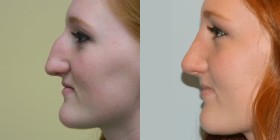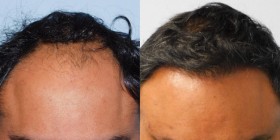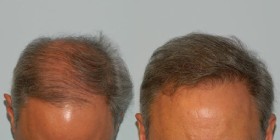Otoplasty
Conveniently located to serve the areas of Philadelphia, PA

If you were born with prominent or projecting ears, ear surgery – or otoplasty – can help you have nicely-balanced ears that lie back against your head.
Contents
- 1 Before and After Photos
- 2 Otoplasty Overview
- 3 Elegant Ear Transformations
- 4 Why Choose Dr. Pontell for Ear Surgery?
- 5 What Is Otoplasty?
- 6 What Does Otoplasty Achieve?
- 7 Benefits of Ear Surgery
- 8 Who Is the Best Candidate for Otoplasty?
- 9 What Does Otoplasty Entail?
- 10 Expectations
- 11 Revision Otoplasty
- 12 FAQ
Before and After Photos
Otoplasty Overview
Otoplasty, also known as ear surgery, is a cosmetic procedure performed to improve the position, shape, and/or size of the ears. The surgery is most commonly performed to correct protruding ears or abnormally shaped ears. Otoplasty typically entails making small incisions and adjusting the appearance of the ears with sutures.
- Average Cost Range: Around $8,000
- Discomfort Level: Mild
- Anesthesia Options: Local Anesthesia with Sedation or General Anesthesia
- Recovery Period: 5 to 10 Days
- Results Length: Permanent, although minor revisions may be needed down the road
- Potential Benefits: Improving the appearance of the ears, improving the symmetry of the ears, correcting ear abnormalities, correcting protruding ears, increasing self-confidence, enhancing facial symmetry
Elegant Ear Transformations
This surgery involves placing sutures to reshape and bend the ear cartilage to give a naturally appearing and attractive ear shape. Ear surgery in Philadelphia has proven to be life-changing and a dramatic confidence booster.
Why Choose Dr. Pontell for Ear Surgery?

Dr. Jonathan Pontell brings 27 years of experience in the specialized discipline of facial plastic surgery, making him one of the top surgeons performing otoplasty in Philadelphia.
With double board certification, Dr. Pontell utilizes the most advanced surgical techniques to perform facial enhancements with highly satisfying results.
Dr. Pontell’s state-of-the-art Aesthetic Facial Plastic Surgery Center offers a luxurious, spa-like experience for patients to feel maximal comfort while pursuing their aesthetic dreams. To ensure patients feel taken care of from start to finish, Dr. Pontell makes himself readily available 24 hours a day, seven days a week, by cell phone to every one of his patients. His expertise and compassionate care make him a trusted expert by professionals and patients alike.
What Is Otoplasty?
Ears that pop out from the side of the head can be embarrassing and unflattering. Many people are insecure about large, protruding ears that cause the face to appear unattractive and unusual. Unfortunately, this is one of the characteristics of the face a person cannot change on their own, so any changes to the shape or position of the ears require surgical expertise.
Otoplasty, or ear surgery, is an option to correct the appearance of the ears. A common procedure performed on children, otoplasty is also a surgery that can be an option for adults who have been suffering from the torment caused by having large ears their entire lives. After undergoing otoplasty, patients can achieve ears that sit back on the face and create better facial balance.
What Does Otoplasty Achieve?
Correction of Prominent Ears
Most Philadelphia otoplasty patients are children who have become targets of ridicule and teasing from their peers due to large or protruding ears. Adults may have put off surgery and later undergo otoplasty to help them feel better about themselves. Otoplasty is performed to bring the ears closer to the head or correct the appearance of large, prominent ears.
Better Facial Harmony
Every characteristic of the face affects a person’s overall look. When it comes to the ears and their role in facial harmony, instead of being a focal area of the face, they work better when they are less conspicuous. After otoplasty, patients are rewarded with proportional ears that blend well with the rest of the facial features and create overall better facial harmony.
Increased Self-Confidence
Large, protruding ears have prompted unwanted nicknames such as “Dumbo.” Hurtful words describing a person with abnormal ears can haunt them and may result in a significant decline in their overall self-confidence. After undergoing otoplasty, patients find that they are happy with how their ears look and that this dramatic change has provided them with overall gratifying results. They feel more confident and less self-conscious about their physical presence.
Benefits of Ear Surgery
Ear surgery corrects concerns you may be unhappy about that can be hard to hide. If you aren’t happy with how your ears look, their appearance can be embarrassing or cause a lack of self-confidence. When it comes to children, those with prominent or unusually-shaped ears can become a target for bullying.
Ear surgery resolves these concerns. Further benefits include the following:
- Provides a proportionate appearance
- Corrects lop ear deformity
- Reshapes long or particularly prominent earlobes
- Repairs ear trauma, including the loss of an ear
- Typically has a short recovery time
- Improves self-esteem and quality of life
- Permanent results
- Safe procedure
Who Is the Best Candidate for Otoplasty?
Ideal candidates for otoplasty in Philadelphia have large, protruding ears that they would like to have corrected. Children should be at least five years of age, as this is when the ears generally reach the majority of full growth. It is important that young patients can communicate their feelings, want to undergo the procedure, and are healthy without any serious illnesses. Adults should be in good health, non-smokers, and realistic about their expectations.
What Does Otoplasty Entail?
Consultation
Before your ear surgery in Philadelphia, you will meet with Dr. Pontell, and he will go over the surgical process. He will evaluate your medical history, current health, and goals and address your concerns. Dr. Pontell will examine your ears and suggest the best approach for achieving the most aesthetically pleasing outcome. He will use computer imaging to give you a good idea of what to expect from the procedure.
Procedure
Dr. Pontell starts by making an incision on the back of the ear along the back of the ear. He will reshape and sculpt the ear cartilage to correct ears that protrude so that the ears sit closer to the head. Once the cartilage is reshaped, the incision will be closed with stitches. Patients will have a scar on the back of the ear, but because the incision is placed in an inconspicuous area, the scars are barely noticeable.
Expectations
The head will be wrapped with bandages to assist in proper healing and to secure the ears in the correct position. After a few days, the dressing will be replaced with a small headband. Patients will likely feel some pain and throbbing in the ears for a couple of days. However, Dr. Pontell will prescribe oral pain medication to help alleviate any discomfort.
For the best ear surgery results that Main Line offers, patients must keep the head elevated to avoid putting any pressure on the ears. Children should have a responsible adult care for them during their recovery process. Patients should not engage in strenuous activities for the first two weeks after surgery. Most patients go back to work after a week or less.
Revision Otoplasty
Although otoplasty is a safe and effective procedure, and the vast majority of patients are very happy with the results, some patients may be unsatisfied with their results or experience unexpected changes to the ears. It is vital that patients who are considering a revision otoplasty make sure their ears are fully healed and that they have waited at least six months since their initial surgery.
FAQ
How long will my otoplasty results last?
Since the ears do not grow or change after a certain age, the results will be permanent once the corrections performed during otoplasty are made.
What type of anesthesia is used for otoplasty?
Otoplasty can be performed using local anesthesia, intravenous sedation, or general anesthesia. If the surgery is done under local anesthesia, medications are administered before the procedure to provide the patient with additional comfort.
What are the risks and complications associated with otoplasty?
As with any surgical procedure, otoplasty has a few risks. These include infection, anesthesia risks, poor wound healing, unfavorable scarring, lack of symmetry, and bleeding.
Can otoplasty affect my hearing?
The mechanism for hearing is located inside the ears. Otoplasty only involves altering the outside of the ears, so it will not affect a patient’s hearing.












